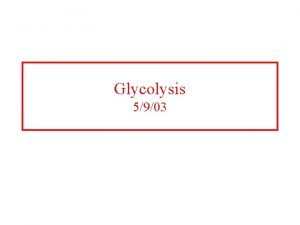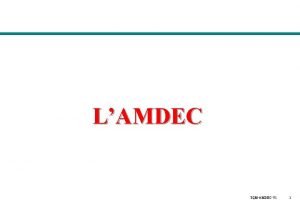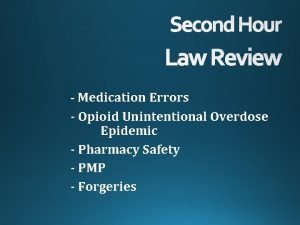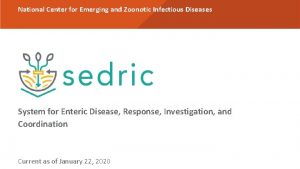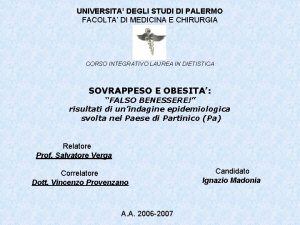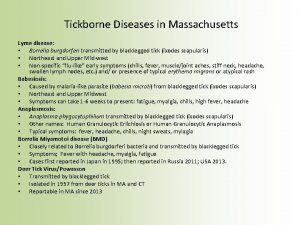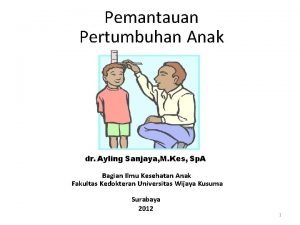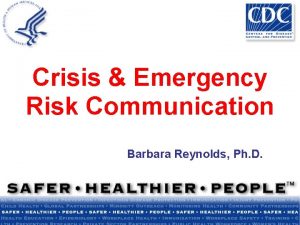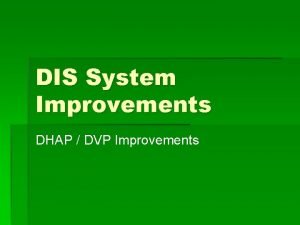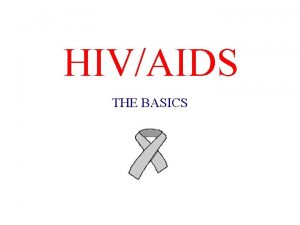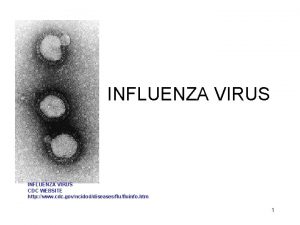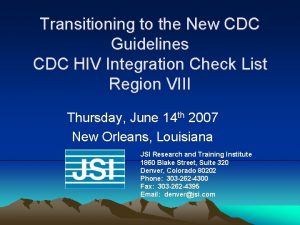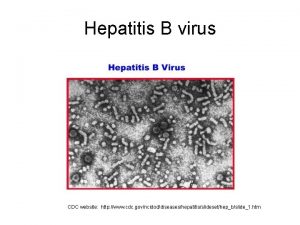CDC Division of HIVAIDS Prevention DHAP Update to
















- Slides: 16

CDC, Division of HIV/AIDS Prevention (DHAP) Update to the Federal AIDS Policy Partnership Eugene Mc. Cray, MD Director, DHAP NCHHSTP, Office for Infectious Diseases, CDC March 4, 2015 National Center for HIV/AIDS, Viral Hepatitis, STD, and TB Prevention Division of HIV/AIDS Prevention

DHAP – Mission and Key Areas Mission: To promote health and quality of life by preventing HIV infection and reducing HIV-related illness and death in the U. S. Supporting Prevention Programs Tracking the HIV Epidemic Supporting Prevention Research Raising Awareness

DHAP Budget (2014) 11% 89% Extramural Intramural

Funding for Maximum Impact DHAP projects by mission category, total $665. 99 Million (2014)* 3% 2% 8% Prevention Programs 15% Surveillance Technical Assistance 72% Operational Research Program Evaluation

Priorities q Reducing New Infections § § § q Improving Surveillance and use of data § q Expanded HIV testing in clinical and non-clinical settings “Prevention for Negatives” “Treatment as Prevention” Strengthen surveillance systems by improving data quality and data use to target and evaluate prevention efforts Expanding HIP Activities § Transition CBOs to HIP prevention approach

Prioritizing interventions that are… Advancing High-Impact Prevention (HIP) ü Scientifically proven ü Cost-effective ü Scalable … targeted to the right populations in the right geographic areas. . . to achieve the greatest potential impact on the epidemic 6

FY 16 President’s Budget Request q President’s FY 2016 funding request for NCHHSTP was $44. 14 M higher than 2014 enacted § The request was $12. 65 M higher than 2014 enacted funding levels for HIV prevention activities, including $6. 4 M to improve program effectiveness and $6. 3 M for HIV-prevention education in schools q HIV and AIDS prevention investments will continue to align activities with the NHAS and promote high-impact prevention that focuses resources on effective, scalable, and sustainable prevention strategies

High-Impact Prevention Progress Update for Health Department Program (12 -1201) Successes ü Expanded prevention and care services and coordination ü HD efforts in MSAs w highest burden of disease ü Jurisdictions meeting FOA routine HIV testing objectives and increasing potential for retention in care ü Increased routine testing in healthcare settings Challenges ü Social issues – stigma ü Social determinants of health ü Healthcare system transformation* ü Human capital/capacity Opportunities ü Meet current FOA requirements ü New biomedical strategies ü Information and resources for MSM & providers ü Increase utilization of surveillance data ü New approaches to planning ü More diverse engagement of non-traditional partners ü Healthcare system transformation*

Supporting LGBT Work & Mitigating Poor Health Outcomes for MSM In addition to funding… Funding targeted towards communities experiencing heaviest disparities. Organization Leadership & Inclusion • DHAP as coordinating office for domestic HIV, MSM activities through CDC Surveillance • Monitor trends in HIV incidence, prevalence, risk behaviors Research • Increase understanding of drivers of HIV transmission • Develop interventions and messaging in MSM in close partnership with communities Programs • MSM testing initiative • YMSM of color & transgender youth • Training and capacity building; support for organizations serving MSM

Prevention Efforts in Transgender Community q Surveillance reporting § 80% of jurisdictions reported that they collect transgender-specific data § Although, issues exist with collecting and reporting transgender surveillance data q q Technical assistance guidance Funding (YMSM, Transgender FOA -- PS 11 -1113) § $55 M over five years to provide effective HIV prevention services § Commitment to renew for FY 2017 q New research § Life Skills (for young transgender women aged 16 -24) § Girlfriends (for adult transgender women) q Public HIV campaigns § Let’s Stop HIV Together § Testing Makes Us Stronger

ACA: Essential Health Benefits “If an issuer places most or all drugs that treat a specific condition on the highest cost tiers, we believe that such plan designs effectively discriminate against, or discourage enrollment by, individuals who have those chronic conditions. ” Notice of Benefit and Payment Parameters for 2016 Rule, CMS q q q Covers a range of drugs across a broad distribution of therapeutic categories and classes and recommended drug treatment regimens treating all disease states without discouraging enrollment by any group of enrollees Requires issuers’ formularies to provide appropriate access to drugs included in broadly accepted treatment guidelines/best practices Changes should improve access to optimal preventative and treatment regimens for HIV and related comorbidities

Testing Reimbursement q DHAP is supporting grantee efforts to address these challenges by: § Redirecting funds to support billing related activities § Supporting a network of capacity building assistance providers who can offer billing related technical assistance grantees; and § Redesigning the NACCHO billing toolkit q DHAP recognizes payment models are rapidly evolving, and we need to prepare for both the present and future by: § Positioning key public health partners, as recognized providers of valued health services § Actively partnering with key payers and policy innovators to develop and test new models for delivering and paying for care

Infrastructure & System Implications q q Variation exists within and across states making it difficult to provide universal guidance DHAP initiated program changes and demonstration projects: will integrate HIV into larger healthcare delivery system when complete § Example: Partnerships for Care (P 4 C) aims to identify and develop effective models for partnership between Federally Qualified Health Centers (FQHCs) and health departments (HDs) to support HIV prevention and care. q Also, actively supporting transformation efforts through many of our core FOAs (CBOs, CBAs, etc. )

HIV Criminalization q DOJ – leads government’s response to laws that criminalize HIV exposure q CDC – provides information that policy makers use in drafting/revising criminalization laws § Current HIV exposure laws § Evidence about the risks of transmission “Given that HIV-specific criminal laws may have wideranging social implications, states are encouraged to utilize the findings of this paper as a basis to reexamine those laws, assess the laws’ alignment with current evidence regarding HIV transmission risk, and consider whether current laws are the best vehicle to achieve their intended purposes. ” Source: Lehman JS, Carr, MH, Nichol AJ, et al. Prevalence and public health implications of state laws that criminalize potential HIV exposure in the United States. AIDS Behav 2014.

DHAP Publications and Resources Available by visiting the DHAP website: www. cdc. gov/hiv/dhap/about. html Or by calling: 1 -800 -CDC-INFO Division of HIV Prevention Centers for Disease Control and Prevention Corporate Square, Atlanta GA MS D-21 National Center for HIV/AIDS, Viral Hepatitis, STD, and TB Prevention Division of HIV/AIDS Prevention

Q&A / DISCUSSION 16
 Primary prevention secondary prevention tertiary prevention
Primary prevention secondary prevention tertiary prevention Ann arbor sınıflaması
Ann arbor sınıflaması Tim enzyme
Tim enzyme Alternative of log based recovery
Alternative of log based recovery Dfpc jprs
Dfpc jprs Syntehtic division
Syntehtic division Long division vocabulary
Long division vocabulary What is synthetic division
What is synthetic division 369 times 2
369 times 2 Amdec processus exemple
Amdec processus exemple Cdc.gov
Cdc.gov Sedric cdc
Sedric cdc Curve di crescita cacciari
Curve di crescita cacciari Lyme
Lyme Dr ayling
Dr ayling Cdc jobs overseas
Cdc jobs overseas Starcc principle
Starcc principle


